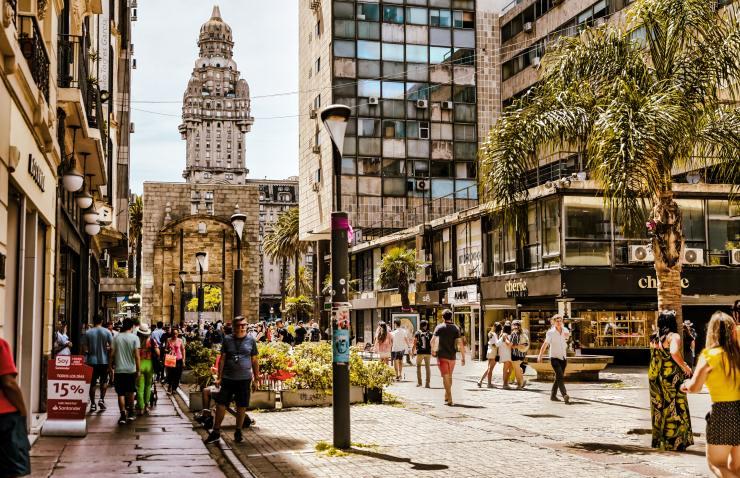Between China and EU.

Despite the privileged position it enjoys and the fertility of its land, Uruguay presents a large disproportion between its territorial area of 176, 215 thousand km², and the number of its inhabitants equal to 3, 5 million, comparable to those of any capital.
Of these, approximately 1,381,000 live in the capital Montevideo. In the opinion of some historians, this disproportion is linked to the historical origins of the birth of the country, strongly desired by English diplomacy but without concrete cultural reasons. This artificiality, determined by the desire to create a buffer between the Spanish and Portuguese empires, between Argentina and Brazil, in a key area for the navigation of the rivers leading to the heart of Latin America, has had a negative impact on the increase in population. It was the migratory flows of the late 19th and early 20th centuries, coming mostly from Spain and Italy, but also from Brazil and Argentina albeit to a lesser extent, that caused the inhabitants to grow in number.
It is estimated that around 600,000 people entered Uruguay from Europe between 1860 and 1920, transforming Montevideo into a cosmopolitan city, inhabited by Spaniards, Brazilians, Italians, French, English, Portuguese and other foreign communities. In the opinion of other historians, the development of the country in terms of population was conditioned by the indigenous factor.

Montevideo. Interior of the Mercado del Puerto.The majority of the Uruguayan GDP is made up of services. Shutterstock/ quiggyt4
According to this thesis, the Guarani and the indigenous Charruas, who inhabited those territories, continued to maintain control even after the arrival of the Europeans, and in particular of the internal part of the country, forcing the new arrivals to remain on the coast.
Today, indigenous peoples are almost extinct, even though 30% of the current population descends from them.
Since its birth, the country has presented itself as a secular state. Furthermore, unlike other countries in the region, Uruguay has not undergone the process of colonization of indigenous peoples. Despite this, Catholicism constitutes an essential component of national culture even if Catholics represent only 42% of the population. Concerning other religious cults, the presence of Protestants is recorded, equal to 16%, and there are 17% who profess to be believers but without affiliation, 16% are atheists, 5% are agnostics and 5% belong to other religions.
From an administrative point of view, the country is divided into 19 Departments each governed with a degree of autonomy from its relative executive bodies, by the mayor and by the Departmental Council. Mayors are elected by universal suffrage every five years.
While at a national level, the highest institution is the President of the Republic, who is elected directly by the people and whose mandate is not immediately renewable. He heads Executive Power and has the power to designate and dismiss Ministers.

Montevideo. Legislative Palace. Legislative power lies with the General Assembly, made up of two Chambers: The House of Representatives and the Senate. Shutterstock/Leonid Andronov
Together with the President, the Vice President is also elected, who automatically becomes President of the General Assembly and President of the Senate and in the event of temporary or permanent impediment of the President of the Republic in office, the Vice President takes over his duties. Legislative power lies with the General Assembly, made up of two Chambers: The House of Representatives and the Senate, within the framework of a perfect bicameral system, made up respectively of 99 and 30 members elected with a proportional system.
From an economic point of view, the country recorded interrupted growth in GDP from 2003 to 2019, mainly due to a significant increase in private consumption and the relaunch of exports. A relatively favourable situation that allowed Uruguay to face the global economic crisis caused by Covid-19.
The majority of the Uruguayan GDP is made up of services which correspond to approximately 70% of the total, the industrial sector equals 20%, while the primary sector stands at 10%, constituting, however, an important item in the export chapter. Cereal crops and livestock represent the two major sectors of this sector, despite the problems linked to drought and the reduction of freshwater basins.

Uruguay holds the record for the highest number of cows per inhabitant in the world. 123rf
Uruguay, in particular, holds the record for the highest number of cows per inhabitant in the world, equal to 11 million, almost triple the local population and beef represents the main export, with sales of two and a half billion dollars in 2022, of which China is among the largest importers. However, a Memorandum of Understanding was also signed with Beijing to strengthen economic cooperation in the sectors of artificial intelligence and technological innovation, of which the Huawei company is the leader and in that of renewables. The United States, in order to stem Chinese penetration, is also intensifying its investments in both the technological and agricultural fields. Furthermore, partnership with the EU is also of great interest to Montevideo as it constitutes the main foreign investor in Uruguayan territory. This partnership is greatly facilitated by the country’s recent infrastructural development which has allowed trade in goods and services between EU countries and Uruguay to make a leap of 15% more in 2022, reaching the record figure of 3.9 billion euros, of which 1.8 exclusively in the trade of services. (Open Photo: Pedestrians on a wide walkway outside of Museo Toerres Garcia in the old town of Montevideo. Shutterstock/ Todamo)
Filippo Romeo



